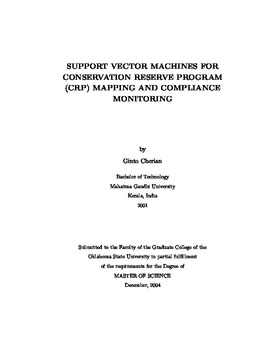| dc.contributor.advisor | Fan, Guoliang | |
| dc.contributor.author | Cherian, Ginto | |
| dc.date.accessioned | 2014-04-17T20:08:22Z | |
| dc.date.available | 2014-04-17T20:08:22Z | |
| dc.date.issued | 2004-12-01 | |
| dc.identifier.uri | https://hdl.handle.net/11244/10191 | |
| dc.description.abstract | This research focuses on two specific remote sensing problems associated with the United States Department of Agriculture (USDA)'s Conservation Reserve Program (CRP). The CRP program seeks to convert highly erodible lands with active crop production to permanent vegetative cover. Specifically, there are two essential needs pertaining to CRP management and evaluation, i.e., CRP compliance monitoring and CRP mapping. Multi-spectral and multi-temporal Landsat TM images are used to generate the data. Compliance monitoring checks if a CRP tract is following the contract stipulations. CRP mapping produces up-to-date and accurate maps of CRP lands based on satellite images. We invoke approaches based on the Support Vector Machine (SVM) to address these two issues where two classes, CRP and non-CRP, are involved for data classification. The SVM is a recently developed supervised classifier aiming at maximizing the margin between two clusters in a projected feature space. The SVM was also adapted to solve one-class problems, i.e., novelty detection. The one-class SVM (OCSVM) has a parameter ν to control the percentage of outliers or minority data. We propose two SVM-based methods for CRP compliance monitoring. The first method uses OCSVMs trained with different ν values and selects the one producing the maximum margin between clusters in the projected space. Then a two-class SVM (TCSVM) is trained by using the initial OCSVM classification results. The second method only involves the OCSVM training once. Training samples for the TCSVM are selected based on their relative locations to the classification boundary in the projected feature space i.e. SVM scores. The second method is proven more efficient than the first one with similar or better accuracy. We also develop an OCSVM based algorithm for CRP mapping. Reduction in classifier complexity is achieved by combining different CRP species based on their data distribution in a projected feature space. Multiple OCSVMs are trained on different CRP cover types, and are applied for CRP classification individually. The complete CRP map is obtained by merging the different classifier outputs. This research further manifests the usefulness of the SVM in remote sensing applications. The proposed compliance monitoring and mapping tools will be valuable for CRP management and evaluation. | |
| dc.format | application/pdf | |
| dc.language | en_US | |
| dc.publisher | Oklahoma State University | |
| dc.rights | Copyright is held by the author who has granted the Oklahoma State University Library the non-exclusive right to share this material in its institutional repository. Contact Digital Library Services at lib-dls@okstate.edu or 405-744-9161 for the permission policy on the use, reproduction or distribution of this material. | |
| dc.title | Support Vector Machines for Conservation Reserve Program (CRP) Mapping and Compliance Monitoring | |
| dc.type | text | |
| dc.contributor.committeeMember | Chung, Jong-Mong | |
| dc.contributor.committeeMember | Yen, Gary G. | |
| dc.contributor.committeeMember | Rao, Mahesh | |
| osu.filename | Cherian_okstate_0664M_1173.pdf | |
| osu.college | Engineering, Architecture, and Technology | |
| osu.accesstype | Open Access | |
| dc.description.department | School of Electrical & Computer Engineering | |
| dc.type.genre | Thesis | |
| dc.subject.keywords | support vector machines | |
| dc.subject.keywords | one-class support vector machines | |
| dc.subject.keywords | conservation reserve program | |
| dc.subject.keywords | kernel space | |
| dc.subject.keywords | landsat tm | |
